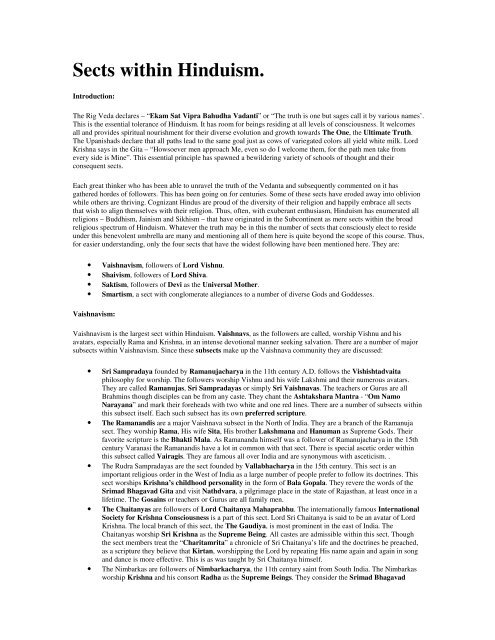Create successful ePaper yourself
Turn your PDF publications into a flip-book with our unique Google optimized e-Paper software.
Sects within <strong>Hinduism</strong>.<br />
Introduction:<br />
The Rig Veda declares – “Ekam Sat Vipra Bahudha Vadanti” or “The truth is one but sages call it by various names’.<br />
This is the essential tolerance of <strong>Hinduism</strong>. It has room for beings residing at all levels of consciousness. It welcomes<br />
all and provides spiritual nourishment for their diverse evolution and growth towards The One, the Ultimate Truth.<br />
The Upanishads declare that all paths lead to the same goal just as cows of variegated colors all yield white milk. Lord<br />
Krishna says in the Gita – “Howsoever men approach Me, even so do I welcome them, for the path men take from<br />
every side is Mine”. This essential principle has spawned a bewildering variety of schools of thought and their<br />
consequent sects.<br />
Each great thinker who has been able to unravel the truth of the Vedanta and subsequently commented on it has<br />
gathered hordes of followers. This has been going on for centuries. Some of these sects have eroded away into oblivion<br />
while others are thriving. Cognizant Hindus are proud of the diversity of their religion and happily embrace all sects<br />
that wish to align themselves with their religion. Thus, often, with exuberant enthusiasm, <strong>Hinduism</strong> has enumerated all<br />
religions – Buddhism, Jainism and Sikhism – that have originated in the Subcontinent as mere sects within the broad<br />
religious spectrum of <strong>Hinduism</strong>. Whatever the truth may be in this the number of sects that consciously elect to reside<br />
under this benevolent umbrella are many and mentioning all of them here is quite beyond the scope of this course. Thus,<br />
for easier understanding, only the four sects that have the widest following have been mentioned here. They are:<br />
• Vaishnavism, followers of Lord Vishnu.<br />
• Shaivism, followers of Lord Shiva.<br />
• Saktism, followers of Devi as the Universal Mother.<br />
• Smartism, a sect with conglomerate allegiances to a number of diverse Gods and Goddesses.<br />
Vaishnavism:<br />
Vaishnavism is the largest sect within <strong>Hinduism</strong>. Vaishnavs, as the followers are called, worship Vishnu and his<br />
avatars, especially Rama and Krishna, in an intense devotional manner seeking salvation. There are a number of major<br />
subsects within Vaishnavism. Since these subsects make up the Vaishnava community they are discussed:<br />
• Sri Sampradaya founded by Ramanujacharya in the 11th century A.D. follows the Vishishtadvaita<br />
philosophy for worship. The followers worship Vishnu and his wife Lakshmi and their numerous avatars.<br />
They are called Ramanujas, Sri Sampradayas or simply Sri Vaishnavas. The teachers or Gurus are all<br />
Brahmins though disciples can be from any caste. They chant the Ashtakshara Mantra - “Om Namo<br />
Narayana” and mark their foreheads with two white and one red lines. There are a number of subsects within<br />
this subsect itself. Each such subsect has its own preferred scripture.<br />
• The Ramanandis are a major Vaishnava subsect in the North of India. They are a branch of the Ramanuja<br />
sect. They worship Rama, His wife Sita, His brother Lakshmana and Hanuman as Supreme Gods. Their<br />
favorite scripture is the Bhakti Mala. As Ramananda himself was a follower of Ramanujacharya in the 15th<br />
century Varanasi the Ramanandis have a lot in common with that sect. There is special ascetic order within<br />
this subsect called Vairagis. They are famous all over India and are synonymous with asceticism. .<br />
• The Rudra Sampradayas are the sect founded by Vallabhacharya in the 15th century. This sect is an<br />
important religious order in the West of India as a large number of people prefer to follow its doctrines. This<br />
sect worships Krishna’s childhood personality in the form of Bala Gopala. They revere the words of the<br />
Srimad Bhagavad Gita and visit Nathdvara, a pilgrimage place in the state of Rajasthan, at least once in a<br />
lifetime. The Gosains or teachers or Gurus are all family men.<br />
• The Chaitanyas are followers of Lord Chaitanya Mahaprabhu. The internationally famous International<br />
Society for Krishna Consciousness is a part of this sect. Lord Sri Chaitanya is said to be an avatar of Lord<br />
Krishna. The local branch of this sect, the The Gaudiya, is most prominent in the east of India. The<br />
Chaitanyas worship Sri Krishna as the Supreme Being. All castes are admissible within this sect. Though<br />
the sect members treat the “Charitamrita” a chronicle of Sri Chaitanya’s life and the doctrines he preached,<br />
as a scripture they believe that Kirtan, worshipping the Lord by repeating His name again and again in song<br />
and dance is more effective. This is as was taught by Sri Chaitanya himself.<br />
• The Nimbarkas are followers of Nimbarkacharya, the 11th century saint from South India. The Nimbarkas<br />
worship Krishna and his consort Radha as the Supreme Beings. They consider the Srimad Bhagavad
















